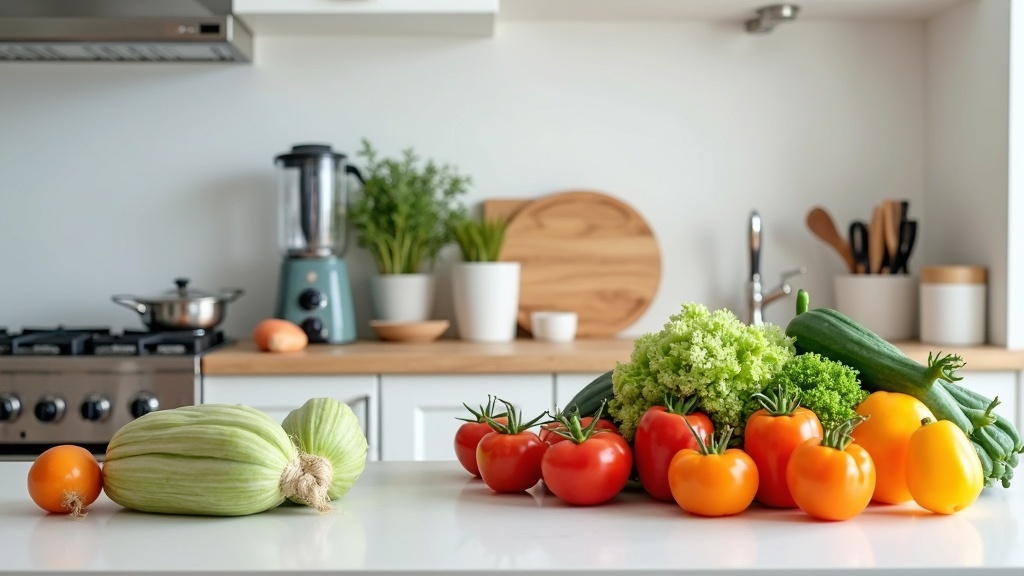A plantbased lifestyle opens up a whole new world of flavors and nutrition, but making the switch can seem overwhelming if your kitchen isn’t ready for it.
Over the years, I’ve learned that having the right kitchen tools can make prepping plantbased meals way more fun and much less stressful.
This guide breaks down the kitchen basics that make cooking with plants efficient, enjoyable, and satisfying, even for those just starting out.

Top Kitchen Tools for a Plantbased Kitchen
A plantbased kitchen often looks a little different from a traditional kitchen.
The focus is on maximizing flavor and nutrition from veggies, grains, beans, nuts, and seeds.
For me, making sure I have the right equipment to chop, blend, steam, and store these ingredients easily is key.
A few handy tools can turn what might seem like a timeconsuming prep into a quick, almost effortless routine.
Keeping up with useful gadgets also helps cut down on waste and lets you experiment with new recipes without any complications.
The demand for plantbased foods and kitchen tools has really grown.
According to the Plant Based Foods Association, sales in this market keep rising every year, proving how many people want to fill their kitchens with tools that support healthy routines.
As the popularity of plantbased eating spreads like wildfire.
Stores now have far more options for interesting gadgets, making it easier for newcomers and longtimers alike to step up their meal prep.
Brands are also swapping out materials for more ecofriendly choices, like bamboo utensils and silicone baking mats.
So you can cook amazing dishes and care for the planet at the same time.
Getting Ready to Prep Plantbased Meals
Once you start cooking meals built around fruits, vegetables, grains, and legumes, you’ll notice that certain tools show up again and again in recipes and meal prep routines.
Having these basics covered means you can pull together everything from hearty soups to colourful salads without reaching for specialty gear every time.
Starting with the right tools reduces your time in the kitchen and helps with consistency.
Many of these items are onetime purchases, so think about what fits your space and style.
Here are a few kitchen item groups I find really useful:
- Cutting and Chopping Tools: Prepping vegetables is a breeze when you have sharp knives and a good cutting board.
- HighPowered Blenders and Food Processors: Great for smoothies, sauces, dips, and plantbased “cheese” or “cream.”
- Cooking Essentials: Includes pots, pans, steamers, and baking sheets, all important for different aspects of plantbased cooking.
- Storage and Organization: Glass containers or reusable bags make batch cooking and leftovers easier to handle.
Jumpstart Guide: Getting Set Up for Plantbased Cooking Success
Transitioning to plantbased meals doesn’t mean you need every gadget on the shelf.
I started with just a basic set and added more as I tried new recipes and found gaps in my kitchen lineup.
Here’s my quickstart guide to building a strong foundation for a plantbased kitchen:
- Start with a Chefs Knife: A sharp, wellbalanced chefs knife is a must for smoothly slicing through everything from potatoes to leafy greens.
- Invest in a Quality Blender: Blenders help with smoothies, creamy soups, or even homemade nut butters. Brands like Vitamix and Blendtec are popular, but there are plenty of midprice options that work great too.
- Pick Up a Good Stockpot: Use this for everything from soups and stews to batchcooking beans and whole grains.
- Grab a Steamer Basket: A simple stainless steel basket can turn almost any pot into a steamer for veggies, dumplings, and potatoes.
- Keep Some Reusable Storage Containers On Hand: These make it much easier to prep meals in advance or keep leftovers organized and fresh.
These basics do a lot to simplify daytoday plantbased meal prep and help you get more comfortable with plantfocused recipes.
What to Think About Before Stocking Up
Some kitchen tools can get pricey, so I always ask myself how often I’ll use something before picking it up.
Doing a little research helps decide what best fits into your habits, space, and budget.
Here are a few considerations:
- Counter Space: Smaller kitchens benefit from multipurpose equipment. Look for food processorblender combos or compact storage sets.
- Durability and Ease of Cleaning: Stainless steel and glass usually last longer and are easier to clean than some plastics or coated cookware.
- Versatility: Choose tools that can handle multiple jobs — like a mandoline with adjustable blades for slicing, dicing, and shredding.
- Budget: Many plantbased kitchen tools come in affordable options. Secondhand shops or online marketplaces often have highquality items at lower prices.
Cutting and Chopping Tools
A chefs knife, paring knife, and sturdy cutting board are probably the gear I reach for most.
I sharpen my knives regularly. Dull blades slow things down and can lead to more kitchen accidents.
A mandoline slicer is also a major timesaver for slicing veggies consistently for salads or stir fries.
Blenders and Food Processors
A powerful blender lets you make green smoothies, pesto, cashew creams, and even vegan ice cream.
Food processors work great for crafting veggie burgers, crusts, hummus, and lots more.
I like having both because they each handle a few things really well, but if you’re tight on space, look for multifunctional blenders that offer food processor attachments.
Pots, Pans, and Steamers
At a minimum, a nonstick skillet and one or two saucepans make it simple to saute, boil, or simmer plantbased staples.
I rely on my large stockpot for homemade vegetable broth and boiling pasta.
Steamers give you an easy way to keep veggies vibrant and nutrientrich, especially compared to boiling.
Ceramic or cast iron cookware is a good choice if you want a nontoxic, sturdy alternative that holds heat well.
Cast iron pans, when seasoned properly, last decades and bring an extra kick of flavor to dishes like plantbased curries or crispy stir fries.
Storage Solutions
Keeping produce and prepped ingredients fresh is just easier with clear glass containers or silicone storage bags.
I love being able to see what’s inside, which helps cut down on accidental food waste.
Labeled containers are handy for meal preppers planning their week in advance.
Freezerfriendly containers allow you to cook big batches of beans, grains, and sauces ahead of time.
Portioning and freezing in these containers saves money and keeps meals ready to go on busy nights.
Bonus Tips to Make the Most of Your Plantbased Kitchen
After the essentials, a few extra items can take your plantbased meal routine up a notch.
These are the tools I reach for when I want to boost creativity or add efficiency to my week.
Spiralizer: Handy for making zucchini noodles or curly fries from root veggies. Adds fun and texture to salads or pasta swaps.
Salad Spinner: Keeps leafy greens dry and crisp, which means longer shelflife and tastier salads.
Grater or Microplane: Use for zesting lemons, grating fresh garlic, or shredding carrots and beets for salads.
Immersion Blender: Really helpful for blending soups and sauces right in the pot, so you don’t have to wash extra containers.
Nut Milk Bag: Makes it super easy to create your own nut or oat milk at home without added preservatives.
Baking Mats: Silicone mats make baking crispy tofu or ovenroasted veggies a breeze, while saving you money on parchment paper in the long run. They clean up fast and are more ecofriendly too.
Digital Scale: Makes portioning a snap and is helpful for following recipes accurately, especially when making breads or delicate raw desserts.
Common Questions About Plantbased Kitchen Tools
People often ask what’s actually needed for plantbased cooking. Here are answers to some of the most frequent questions:
Question: Do I really need a highpowered blender?
Answer:
While it’s not necessary for every recipe, a highpowered blender is super handy if you like smoothies, creamy soups, or making your own nut butters. Standard blenders do work for most tasks, though; it just may take a bit longer or need more liquid.
Question: Is a food processor worth it?
Answer:
If you enjoy making dips like hummus, energy bars, or veggiebased dough, a food processor will save you lots of time. For small kitchens, choosing equipment that combines several functions is a benefit.
Question: Are specialty gadgets like tofu presses or spiralizers needed?
Answer:
These can make meal prep easier, but I suggest waiting until you’re using plantbased ingredients on a regular basis before picking up too many extras. If a recipe comes up often, the right gadget is worth having, but many of these jobs can be handled with what you already own.
Everyday Tools Make Plantbased Cooking Simple
Stocking up with just a few dependable kitchen tools gives you more flexibility and excitement in the kitchen.
For me, building my tool collection over time has helped me enjoy prepping, cooking, and trying new foods.
Whether you’re craving a warming stew or a bright veggie bowl, having the right equipment will help you prep, cook, and store meals with a lot less hassle.
Once your kitchen is ready, cooking plantbased recipes truly becomes quicker, easier, and a lot more fun.
